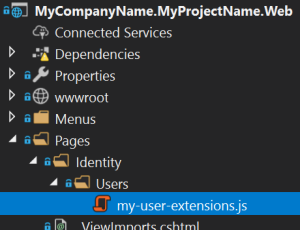Data Table Column Extensions for ASP.NET Core UI
Introduction
Data table column extension system allows you to add a new table column on the user interface. The example below adds a new column with the "Social security no" title:
You can use the standard column options to fine control the table column.
Note that this is a low level API to find control the table column. If you want to show an extension property on the table, see the module entity extension document.
How to Set Up
Create a JavaScript File
First, add a new JavaScript file to your solution. We added inside the /Pages/Identity/Users folder of the .Web project:
Here, the content of this JavaScript file:
abp.ui.extensions.tableColumns
.get('identity.user')
.addContributor(function (columnList) {
columnList.addTail({ //add as the last column
title: 'Social security no',
data: 'extraProperties.SocialSecurityNumber',
orderable: false,
render: function (data, type, row) {
if (row.extraProperties.SocialSecurityNumber) {
return '<strong>' +
row.extraProperties.SocialSecurityNumber +
'<strong>';
} else {
return '<i class="text-muted">undefined</i>';
}
}
});
});
This example defines a custom render function to return a custom HTML to render in the column.
Add the File to the User Management Page
Then you need to add this JavaScript file to the user management page. You can take the power of the Bundling & Minification system.
Write the following code inside the ConfigureServices of your module class:
Configure<AbpBundlingOptions>(options =>
{
options.ScriptBundles.Configure(
typeof(Volo.Abp.Identity.Web.Pages.Identity.Users.IndexModel).FullName,
bundleConfiguration =>
{
bundleConfiguration.AddFiles(
"/Pages/Identity/Users/my-user-extensions.js"
);
});
});
This configuration adds my-user-extensions.js to the user management page of the Identity Module. typeof(Volo.Abp.Identity.Web.Pages.Identity.Users.IndexModel).FullName is the name of the bundle in the user management page. This is a common convention used for all the ABP Commercial modules.
Rendering the Column
This example assumes that you've defined a SocialSecurityNumber extra property using the module entity extension system. However;
- You can add a new column that is related to an existing property of the user (that was not added to the table by default). Example:
abp.ui.extensions.tableColumns
.get('identity.user')
.addContributor(function (columnList) {
columnList.addTail({
title: 'Phone confirmed?',
data: 'phoneNumberConfirmed',
render: function (data, type, row) {
if (row.phoneNumberConfirmed) {
return '<strong style="color: green">YES<strong>';
} else {
return '<i class="text-muted">NO</i>';
}
}
});
});
- You can add a new custom column that is not related to any entity property, but a completely custom information. Example:
abp.ui.extensions.tableColumns
.get('identity.user')
.addContributor(function (columnList) {
columnList.addTail({
title: 'Custom column',
data: {},
orderable: false,
render: function (data) {
if (data.phoneNumber) {
return "call: " + data.phoneNumber;
} else {
return '';
}
}
});
});
API
This section explains details of the abp.ui.extensions.tableColumns JavaScript API.
abp.ui.extensions.tableColumns.get(entityName)
This method is used to access the table columns for an entity of a specific module. It takes one parameter:
- entityName: The name of the entity defined by the related module.
abp.ui.extensions.tableColumns.get(entityName).columns
The columns property is used to retrieve a doubly linked list of previously defined columns for a table. All contributors are executed in order to prepare the final column list. This is normally called by the modules to show the columns in the table. However, you can use it if you are building your own extensible UIs.
abp.ui.extensions.tableColumns.get(entityName).addContributor(contributeCallback [, order])
The addContributor method covers all scenarios, e.g. you want to add your column in a different position in the list, change or remove an existing column. addContributor has the following parameters:
- contributeCallback: A callback function that is called whenever the column list should be created. You can freely modify the column list inside this callback method.
- order (optional): The order of the callback in the callback list. Your callback is added to the end of the list (so, you have opportunity to modify columns added by the previous contributors). You can set it
0to add your contributor as the first item.
Example
var myColumnDefinition = {
title: 'Custom column',
data: {},
orderable: false,
render: function(data) {
if (data.phoneNumber) {
return "call: " + data.phoneNumber;
} else {
return '';
}
}
};
abp.ui.extensions.tableColumns
.get('identity.user')
.addContributor(function (columnList) {
// Remove an item from actionList
columnList.dropHead();
// Add a new item to the actionList
columnList.addHead(myColumnDefinition);
});
columnListis linked list. You can use its methods to build a list of columns however you need.


